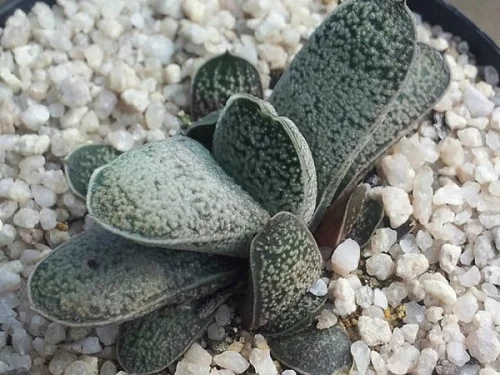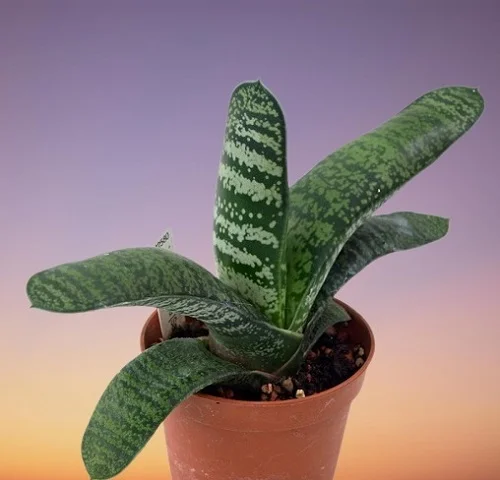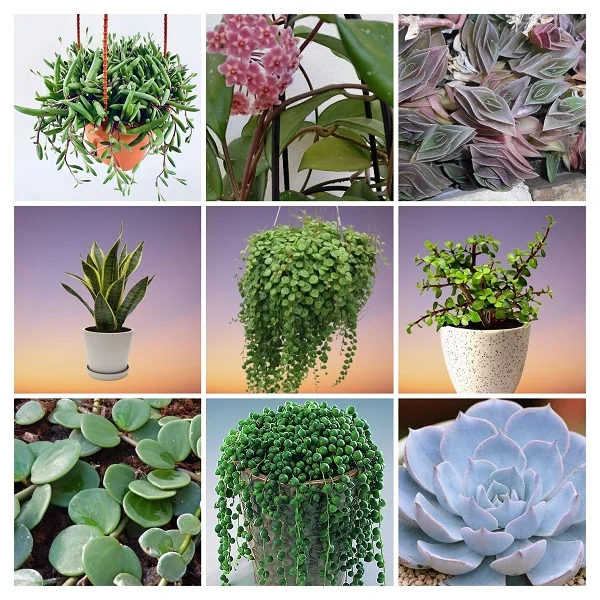12 Types of Gasteria Varieties with Names and Pictures
Some links in this post may be affiliate links
Gasteria are succulent plants with thick, hard, succulent "tongue-shaped" leaves which are arranged in two rows forming a fan-like shape and as it gets older an untidy rosette is formed.
In young Gasteria succulents the leaves are flat strap-shaped and occur in an alternate (spiral) pattern, with each leaf arising at a different point (node) on the stem.
The color of leaves in Gasteria plants vary from dark-green to light-green. Some are spotted with light shades of green or grey-green.

The inflorescence in Gasteria Plants is unique with a curved, stomach-shaped flowers hanging from inclined racemes. This characteristic inflorescence has given this genus its name Gasteria from 'Gaster' which is Latin for stomach.
Gasteria Species are mostly native to Eastern Cape Province of South Africa and extends into the far south-west corner of Namimbia and the Lebombo mountains of Swaziland.
There are as many as 100 names of Gasteria species listed, but, current studies tend to agree that there are between 16 and 23 species.
Gasteria are easy to grow indoor plants which prosper in bright light with 6-8 hours of direct sunlight, average warmth, moderate humidity and moderately moist, fertile, well-drained succulents soil coupled with monthly feeding during the growing season.
Being very resilient plants, Gasteria symbolize endurance. Their ability to withstand harsh conditions makes them perfect beginners' plants.
Gasteria Plants are non-toxic to both humans and pets. They are safe to grow in the home. However, they should not be eaten.
Plants in the Gasteria Genus are similar to and closely related to the genera Aloe and Haworthia. The species of these genera are known to hybridize relatively easily with each other.
If you are looking to add these plants to your collection, we have outlined for you herebelow 12 of the best Gasteria varieties ideal for growing indoors.
12 Gasteria Succulent Varieties for Indoors
The best Gasteria varieties include Gasteria baylissiana, Gasteria disticha, Gasteria rawlinsonii, Gasteria brachyphylla, Gasteria pillansii, Gasteria bicolor, Gasteria carinata among others.
1. Gasteria baylissiana

Gasteria baylissiana is a dwarf succulent plant whose strap-shaped leaves are swollen, convex, rough, leathery and densely covered in tiny, white, truncate tubercles.
The leaves are arranged in two rows forming a fan-like shape which become elongated in shade while in sunnier conditions they remain short and compact.
The inflorescence in Gasteria baylissiana is borne on a stem up to 14 inches long which bears a row of bell-shaped, bright pink and green flowers which are unusually inflated.
2. Gasteria disticha

Gasteria disticha is a dwarf succulent plant whose strap-shaped leaves are arranged in two rows forming a fan-like shape. The leaves are green and have white spots arranged in irregular transverse bands.
The Gasteria disticha plant often has leaves which undulate slightly, have wavy margins and a rough, mat surface. The flowers are tiny and have flower bases that are inflated or swollen for roughly two-thirds of the flower length.
Gasteria disticha is native to the Breede River Valley in the Western Cape, South Africa where it is found growing under the rocks or bushes that provide it with some shelter from the sun.
3. Gasteria rawlinsonii

Gasteria rawlinsonii is an unusual Gasteria plant in that it grows long leafy stems which often hang downwards and the leaves are dark-green and edged with tiny black teeth, unlike in other Gasteria plants.
The inflorescence in Gasteria rawlinsonii has pink flowers which appear throughout the year and and held high above the foliage.
Gasteria rawlinsonii is native to Eastern Cape, South Africa where it is found growing hanging on cliff faces in shady ravines in well-drained sandstone soils.
4. Gasteria brachyphylla

Gasteria brachyphylla is a small succulent plant whose strap-shaped leaves, arranged in two rows forming a fan-like shape are very shiny and smooth. The leaves are green and have white spots arranged in irregular transverse bands.
The name "Brachyphylla" means "wide and short leaves" which is in reference its wide and short leaves. The plant is a profuse bloomer and the flowers are pink.
Gasteria brachyphylla is native to the Little Karoo of Western Cape, South Africa where is is found growing under shrubs in the Succulent Karoo vegetation.
5. Gasteria pillansii

Gasteria pillansii is a small succulent plant whose green, strap-shaped leaves, arranged in two rows forming a fan-like shape, are rough with tiny tubercles.
Gasteria pillansii is a compact plant whose flowers are about 25–45 mm long and have a slightly swollen base for up to one-third of the length which is one ot its distinct features.
Gasteria pillansii is native to the arid winter-rainfall regions in the far west of South Africa and Namibia where it is found growing under rocks or bushes that provide it with shelter from the sun.
6. Gasteria bicolor

Gasteria bicolor also called Gasteria obliqua bear multiple stems that are covered with masses of fleshy mottled leaves and are occasionally keeled and have a sharp pointed at the tip.
Gasteria bicolor is native to a wide area of the Eastern Cape where it is found growing on rocky slopes and outcrops in the thicket vegetation of the region.
It is slow growing plant which prefers bright light, well-drained, rich, moderately moist soil and average to above average warmth. It cannot tolerate frost, therefore, protect it from cold drafts.
7. Gasteria carinata

Gasteria carinata commonly called Bredasdorp Gasteria or Keeled Gasteria bears dark-green, triangular leaves spotted with white tubercles arranged in transverse bands which have sharp points at the tips and channeled on their upper surface.
The flowers are white to light pink with central green stripes and appear on spreading and slightly curved stalks in winter and spring.
Gasteria carinata is native to Western Cape in South Africa where it occurs in dry river valleys, on shale banks and outcrops in the shade of xerophytic shrubs.
8. Gasteria maculata

Gasteria maculata bears thick, fleshy leaves which are rounded below, dark green in color with white specks, arranged in two ranks and are raised with rough edges.
The flowers in Gasteria maculata are pink and orange, bell-shaped and are borne on a 12 in. long stem.
Gasteria maculata is a slow-growing, low-maintenance plant which grows best in shade to bright indirect light away from direct sunlight, average warmth and moderately moist, fertile, loose, well-drained soil.
9. Gasteria glauca

Gasteria glauca also called Kouga Gasteria bears thick, fleshy, smooth, shiny, bluish ("glaucous") leaves which are nearly cylindrical with a pointy tip.
The leaves start off in two opposite rows (distichous) but later become a dense rosette with the inner leaves growing erect while the outer ones are spreading.
Gasteria glauca is an easy to grow Gasteria which is native to the cliff faces overlooking the Kouga River of the Eastern Cape Province of South Africa.
10. Gasteria nitida

Gasteria nitida also called Thurst Gasteria is a stemless, succulent plant with fat, shiny, spotted, triangular leaves which eventually grow in a rosette.
Gasteria nitida is native to the Eastern Cape grasslands of South Africa. The species name, 'nitida' is Latin for 'shiny', in reference to the shiny leaf surface.
Unlike in other Gasterias, the flowers are a darker reddish pink, with yellow throats. The flowers appear in summer on a branched inflorescence.
11. Gasteria armstrongii

Gasteria armstrongii has rough, tuberculate, recurved, purely distichous leaves and a solitary unbranched inflorescence and is thought to be a subspecies of Gasteria nitida.
Gasteria armstrongii which remains in its juvenile phase is native to Eastern Cape Province, South Africa where it is found growing along the Gamtoos river, a flat to hilly terrain rich in pebbles, under full sun or partially covered by small shrubs.
Gasteria armstrongii is the most threatened of all the Gasteria species, as its habitat is rapidly being developed.
12. Gasteria verrucosa

Gasteria verrucosa also called Gasteria carinata var. verrucosa bears upright, dull green leaves patterned with raised white spots, arranged in two opposite vertical rows and is very variable in size and leaf shape.
Gasteria verrucosa is found growing on rocky outcrops and flat areas in limestone fynbos and outliers of subtropical thicket east of Bredasdorp in the Western Cape Province of South Africa.
The flowers are orange-pink, appear in early spring and are borne on long inflorescences upto 3 ft long.

